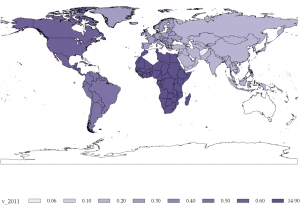What I totally will do again, and what I wish I didn’t have to
Today I’m getting around to day nine of the 20-day blogging challenge while I wait for The Invisible Developer to get out of the shower where he is curled in a fetal position whining about having to go outside when it is 14 below zero. Actually, he is probably just taking a shower, but lots of whining has taken place this week, let me tell you.
Today’s question is what did I do this week that would I do again in teaching or what would I not do again. I think I’ll answer both. Coincidentally, (or maybe not, since I’ve been working on a course re-design to incorporate SAS programming), both of those things have to do with SAS. Short version, if your data are in a form amenable to SAS, it is a godsend for teaching statistics. If your data are not in a very SAS compatible format, it just blows. If, God forbid, you are limited to using SAS On-demand, as I am this week because I have yet to receive the Windows 8 compatible version from the university, and I am in North Dakota, working on my laptop, well then, your life is about to suck, I am sorry to say.
The thing I would totally do again, if I was teaching an epidemiology course, is PROC STDRATE. I love everything about this procedure. The documentation explains the procedure in very plain language which I did not have to rewrite at all for the students, I just included the overview in my livebinder.
“Two commonly used event frequency measures are rate and risk:
-
A rate is a measure of the frequency with which an event occurs in a defined population in a specified period of time. …
-
A risk is the probability that an event occurs in a specified time period. “
It also includes datasets that can be used as an example, and they are easily typed or copied and pasted into your SAS program. Further, these data are very similar in format to the types of data that students will usually come across. Most important, this is one of the most useful procedures for students beginning to learn epidemiology, providing a lot of statistics in one- population attributable risk, population attributable fraction, standardized morbidity rate and more. It will save loads of time over computing statistics on a calculator to answer homework questions – which I think is just silly, because it is 2014 and we have computers. Also, the syntax is relatively easy.
So, that was the good part. What I would never do again, if I had any choice at all, is
a) Use SAS to create maps, or really, analyze in any way, data that was either not already in a SAS dataset or in a very easy to read format, e.g. , no missing data, no variable length variables, and
b) Use the SAS Enterprise Guide version of SAS On-Demand for anything, ever
There are some significant drawbacks of the SAS Web Editor as well but they pale in comparison with the slowness of SAS Enterprise Guide in the on-demand version. While some programs you could maybe get a cup of coffee while waiting for it to run, with the on-demand version of SAS EG you can drive to Starbucks, wait in line, by your coffee, drive back to the office, park, take the elevator to your floor and STILL be there just about when your cross-tabulation had completed. It’s ridiculous, which is sad because if it ran ten times faster it would be a really great tool. It’s terrific on my desktop.
Someone on twitter commented that they hated SAS because it did not play well with open data. Aint that the truth! Now the exception is if you can get your data in a SAS dataset format. Then it’s wonderful. Well, I was using HIV prevalence data from gapminder.org – great site, by the way – and it took me an HOUR to get it read by SAS Web Editor. You can only upload csv files or SAS files to the web editor, so I couldn’t use PROC IMPORT to read in the Excel file. The data I had used country name as the ID and that didn’t match with the ID in the SAS map files – it’s a long sad story with the moral that if I had the option of not using SAS for maps I would certainly be looking into that right now and if I never have to use SAS Enterprise Guide again (which only seems to have the US map in the On-demand version anyway) it will be too soon.
Yes, in the end, I did get my world HIV in the end. The computer will not defeat me!

Keep up on the the 20 day blog challenge. I enjoy reading your blog.